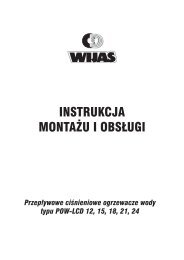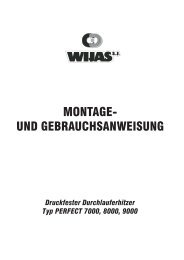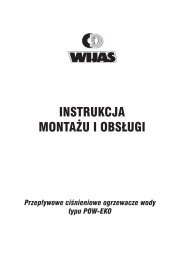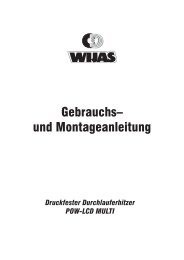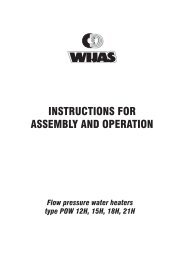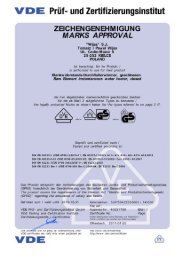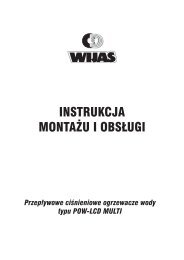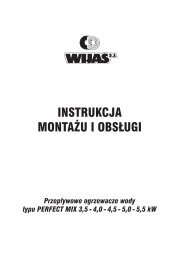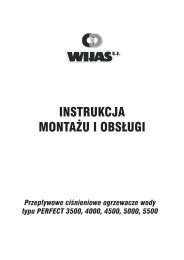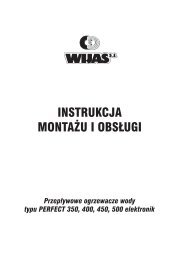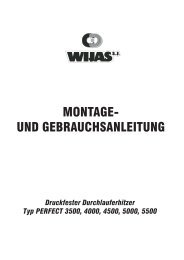Assembly and operating manual for PERFECT 3500, 4000 ... - Wijas
Assembly and operating manual for PERFECT 3500, 4000 ... - Wijas
Assembly and operating manual for PERFECT 3500, 4000 ... - Wijas
Create successful ePaper yourself
Turn your PDF publications into a flip-book with our unique Google optimized e-Paper software.
ASSEMBLY AND OPERATION<br />
MANUAL<br />
Pressurized flow through water heater<br />
<strong>PERFECT</strong> <strong>3500</strong>, <strong>4000</strong>, 4500, 5000, 5500
Advantages of pressurized flow through water heaters “<strong>PERFECT</strong>”<br />
• Serious electric power saving comparing to boiler<br />
• Instant <strong>and</strong> permanent warm water consumption<br />
• Installed electronic power switch prolongs significantly heater’s life<br />
• Possibility to use the heater with very low water pressure (ca 0,06 MPa)<br />
• Thanks to installed electronic control system the most unreliable mechanical parts such<br />
as membrane, traditional electrical contacts are eliminated. Significant prolongation of<br />
the appliance life <strong>and</strong> improved reliability is reached in result.<br />
1. Application<br />
Pressurized flow through water heater <strong>PERFECT</strong> is designed <strong>for</strong> instant delivery of warm<br />
water to sanitary equipment as wash basins, sinks. In order to economical use the heater<br />
should be installed as close as possible to the served equipment.<br />
This appliance is fully designed to be used in moisture environment. However splashing<br />
with water is prohibited. Maximum delivered water temperature should not exceed 30ºC.<br />
One should remember that heater output depends on:<br />
• its electric power;<br />
• water stream flowing through the appliance. The bigger flow, the lower water temperature<br />
on exit (table 1);<br />
• voltage drop in electrical system. For instance: voltage drop by 10% results in lowering<br />
heating output by 19% (table 2). Voltage drop below 185V causes blockage by electronic<br />
system possibility of appliance switching on;<br />
• supplied water temperature.<br />
Table 1. Supplied water temperature 15ºC<br />
Water flow [l/min] 1,5 2 2,5 3 3,5<br />
Perfect <strong>3500</strong> [ O C] 48 40 35 32 –<br />
Perfect <strong>4000</strong> [ O C] 53 43,5 38 34 –<br />
Perfect 4500 [ O C] 59,5 48,5 41 37 –<br />
Perfect 5000 [ O C] 62,5 50,5 43,5 39 35<br />
Perfect 5500 [ O C] – 54 46 41 37,5<br />
2
Table 2. Heater power depending on voltage in electric system<br />
Voltage [V] 230 220 210 200 190<br />
Perfect <strong>3500</strong> [W] <strong>3500</strong> 3200 2917 2646 2390<br />
Perfect <strong>4000</strong> [W] <strong>4000</strong> 3640 3320 3024 2720<br />
Perfect 4500 [W] 4500 4095 3735 3400 3060<br />
Perfect 5000 [W] 5000 4550 4150 3780 3400<br />
Perfect 5500 [W] 5500 5030 4585 4158 3753<br />
CAUTION!<br />
It is strictly <strong>for</strong>bidden to assembly, disconnect <strong>and</strong> incline the heater on<br />
sides while power is switched on.<br />
The device can only work in position showed on drawing below.<br />
Trying to start the device in position other than proper one will result in<br />
damaging a heating element <strong>and</strong> deprivation of guarantee.<br />
Good Wrong WRONG Wrong<br />
2. Safety regulations<br />
Fig.1<br />
• Heater can be installed by authorized person only.<br />
• Heater must permanently be connected to electrical system equipped with earthing<br />
connector <strong>and</strong> differential switch.<br />
• Heater can work in position showed on drawing 1 only.<br />
• Never exchange earthing wire with live wire.<br />
• Heater can only work using perfectly working safety devices.<br />
• Heater must not be installed in rooms where temperature drops below 0ºC.<br />
• Heater should not be installed in aggressive or subject of explosion environment.<br />
• Heater can only be used when is in perfect technical condition.<br />
3
• In case of heater’s defect immediately cut off water <strong>and</strong> power supply.<br />
• All service <strong>and</strong> maintenance works can be completed only with power switched off<br />
• Only original spare parts can be used <strong>for</strong> repair<br />
• Casing should never be disassembled while power is on<br />
• Avoid electronic system to be splashed with water<br />
• In case of heater’s defect or improper work switch off power <strong>and</strong> shut off water supply<br />
using stopping – suppressing valve.<br />
• Water tap drain tube sprinkler (strainer) should be cleaned regularly.<br />
• Power supply system should be periodically checked up (voltage drops), particularly<br />
electrical connections.<br />
• Water flow should be suppressed in such way to avoid excessive temperature (take<br />
care of children).<br />
3. Wiring system<br />
• The heater can only be used previously connected to earthing system.<br />
• Wiring system should be equipped with differential switch.<br />
• Minimum wire cross section <strong>and</strong> fuse value should be selected according to table 3.<br />
• Be<strong>for</strong>e heater’s installation check state of wiring system <strong>and</strong> particularly terminal.<br />
• After heater’s connection to wiring system measure voltage drop under load.<br />
Fig.2<br />
4
Type<br />
Minimum wire cross section<br />
[mm²]<br />
Perfect<br />
<strong>3500</strong><br />
Perfect<br />
<strong>4000</strong><br />
Perfect<br />
4500<br />
Perfect<br />
5000<br />
Perfect<br />
5500<br />
1,5 2,5 2,5 2,5 2,5<br />
Current intensity [A] 15,2 17,4 19,6 21,7 23,9<br />
4. Water system<br />
Table 3<br />
5. <strong>Assembly</strong><br />
CAUTION!<br />
The device can only work in position showed on drawing No 1.<br />
Heater’s installation in position other than proper one or without water filter<br />
can damage heating element <strong>and</strong> cause deprivation of guarantee.<br />
Do not screw connecting hoses with high power in order to avoid threads<br />
damage.<br />
Do not seal stub pipe thread with tow or Teflon sealing tape.<br />
Save electronic system against water splashing.<br />
1. Apply pattern on place the heater will be installed. Mark places <strong>for</strong> drilling holes <strong>for</strong><br />
anchoring pegs <strong>and</strong> cable.<br />
Cable can be connected to the heater in two ways as presented on drawings 3<br />
<strong>and</strong> 4.<br />
5
Fig. 3<br />
Fig. 4<br />
2. Screw heater on.<br />
3. Connect heater in a way showed on fig. 6. Remember to fit water filter as showed on<br />
fig. 5. Use flexible hoses designed <strong>for</strong> pressurized system with rubber gaskets. Do not<br />
exchange heater outlet (red colour) with intake (blue colour).<br />
Caution! Do not screw<br />
up hoses nuts too<br />
tightly in order to<br />
avoid heater’s pipes<br />
thread damage.<br />
Water filter removal<br />
voids guarantee.<br />
Filter must be installed<br />
as showed on drawing<br />
No 5.<br />
6<br />
Fig. 5
Fig.6<br />
Heater connection to tap assembly with hoses 3/8”<br />
Heater connection to tap assembly with hoses 1/2”<br />
7
4. Open water valve <strong>and</strong> check all connections tightness. In case electronic system is<br />
splashed with water, remove it by blowing with compressed air.<br />
5. Open full water flow through the heater in order to deaerate heating element.<br />
6. Connect heater to the power installation.<br />
Fig. 7<br />
Caution!<br />
Every single time after re-instalation of the housing it is necessary to<br />
check carefully whether blue <strong>and</strong> red gaskets on pipe ends fit close to<br />
the heater’s housing nests.<br />
7. Change sprinkler (strainer) mounted on drain pipe <strong>for</strong> the one delivered by heater<br />
manufacturer.<br />
8. Adjust heater according to chapter 6.<br />
9. Remember to clean strainer periodically from dirt.<br />
6. Adjustment<br />
Caution!<br />
Water temperature in flow through heater depends on water flow. The<br />
higher flow, the lower temperature.<br />
Too high water temperature can cause thermal protection device to stop<br />
heater work. Unlock by pressing thermal protection button<br />
1. Open warm water tap.<br />
2. Using suppressing – shutting off valve reduce water flow carefully in order to reach<br />
water temperature ca 42ºC.<br />
8
7. Water filter cleaning<br />
1. Turn off water inflow to suppressing – shutting off valve <strong>and</strong> disconnect from power<br />
line.<br />
2. Disconnect hose from heater intake.<br />
3. Take out filter (using small screw driver – see fig. 8).<br />
Fig. 8<br />
4. Remove dirt from filter.<br />
5. Install filter into heater intake with basket bottom down (Fig. 9)<br />
Fig. 9<br />
6. Connect hose to the heater.<br />
7. Open water valve <strong>and</strong> check tightness.<br />
8. Be<strong>for</strong>e power switching on check electronic system is not splashed with water – if so,<br />
blow up with air to remove water from electronic circuit board.<br />
9. Adjust according to chapter 6.<br />
8. Cleaning drain tube sprinkler (strainer)<br />
1. Unscrew sprinkler from drain tube.<br />
2. Unscrew bolt from sprinkler.<br />
3. Push out rings from sprinkler.<br />
4. Clean up rings’ ducts.<br />
5. Reinstall sprinkler<br />
9
9. Defects <strong>and</strong> repair<br />
Water flow too low<br />
– blocked water filter (clean it out according to chapter 7)<br />
Heater does not start<br />
– heater’s inlet exchanged with outlet<br />
– water flow suppressed too much<br />
– blocked water filter (clean it out according to chapter 7).<br />
– water pressure in system too low<br />
– lack of power because of blown fuse.<br />
Heater does not warm up water but control lamp lights<br />
– voltage too low (power installation overloaded)<br />
– temperature of entering water too low<br />
– water flow too high (adjust water flow according to chapter 6)<br />
Water temperature on heater exit too low<br />
– water flow too high (adjust water flow according to chapter 6)<br />
– temperature of entering water too low<br />
– high voltage drop (see item 1, table 2)<br />
Water temperature on heater exit too high<br />
– water flow suppressed too much by control valve (adjust water flow according to chapter<br />
6)<br />
– blocked water filter (clean it out according to chapter 7)<br />
– water pressure in water system too low<br />
Heater is switching on <strong>and</strong> out automatically<br />
– water pressure oscillation in water system<br />
– water flow suppressed too much by shut off – suppressing valve<br />
Stepwise changes of water temperature on exit<br />
– voltage rush in power supply system<br />
– changes of water flow in result of pressure changes in water system<br />
10
10. Technical data<br />
Type<br />
Perfect<br />
<strong>3500</strong><br />
Perfect<br />
<strong>4000</strong><br />
Perfect<br />
4500<br />
Perfect<br />
5000<br />
Perfect<br />
5500<br />
Power [kW] 3,5 4,0 4,5 5,0 5,5<br />
Current intensity[A] 15,2 17,4 19,6 21,7 23,9<br />
Voltage [V] 230 230 230 230 230<br />
Minimum switching water<br />
flow [l/min]<br />
Maximum water pressure<br />
[MPa]<br />
1,1 1,25 1,4 1,5 1,6<br />
0,65 0,65 0,65 0,65 0,65<br />
Splash-proof class IP24 IP24 IP24 IP24 IP24<br />
Minimum water resistivity<br />
at 15ºC<br />
1300 1300 1300 1300 1300<br />
11. Specification<br />
1. Heater 1 pc<br />
2. Shutting off – suppressing ball valve 1 pc<br />
3. Water filter 1 pc<br />
4. Self – blocking peg Ø6 2 pcs<br />
5. Pattern to drill holes 1 pc<br />
6. Sprinkler (strainer) 1 pc<br />
7. Reduction pipe1/2” <strong>for</strong> 3/8” 1 pc<br />
8. Rubber gaske 1 pc<br />
11



